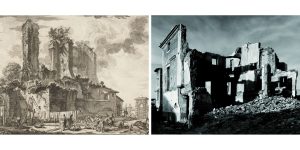Biografia
Italian engraver, archaeologist and architect. His father, an expert stonemason and master builder, introduced him to the study of architecture. In Venice, he had studied perspective and scenery’s design, as well as frequented circles around Giambattista Tiepolo and Canaletto, who left an important mark on his imagery and artistic expression. He settled in Rome in 1740. Piranesi is one of the greatest exponents of the engraving history of art together with Durer, Rembrandt, Goya and Picasso. Unlike these artists, basically painters, Piranesi concentrated all his energy and creativity in the field of engraving. His engraved work testifies to the universality of his genius: as a historicist archaeologist, as a polemic defender of romanity, as promoter of decorative designs and introducer of new styles... Piranesi's critical fortune is due, fundamentally, to two of his works, the "Vedute" and the "Carceri". The series "Vedute di Roma" with more than one hundred engravings, published after 1745 and made throughout his career, describes the monumental splendor of ancient and modern Rome. Piranesi made many engravings of architectural details.
"Carceri d'Invenzione" that began around 1745, consists of fantastic imaginary prisons of dark and infinite architecture in which anticipates the romantic delirium. Defender of the superiority of the Roman architecture with respect to the Greek one, published his work "Della magnificenza ed architettura de' Romani" (1761). In addition to the architects, the decor designers and whimsical painters too accused Piranesi’s influence, such as his friend Hubert Robert.



